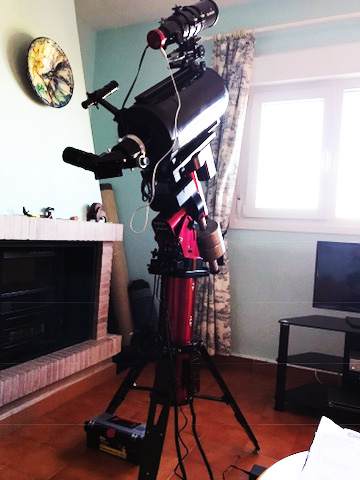Day 5 - R Corona Borealis - Identifying Galaxies in Andromeda - ARP 113 and Halton Arp.
 Sunday, February 16, 2014 at 5:24AM
Sunday, February 16, 2014 at 5:24AM CLICK THROUGH THE LINKS ABOVE TO MOVE FORWARD OR BACK
A short walk this morning with my camera. The image below shows my truck next to the Cabrera Arch with my current residence opposite (yellow dome and round window).
Although the day started well by 6pm clouds had moved in and no astronomy possible. Spent a lot of time on twitter and gained 10 more followers all interested in astronomy. I spent some time setting up my Canon 40D DSLR for when my telescope equipment is set up.
I was going to use the AAVSO VPhot software to solve and do some photometry on some of my historic images but it seems to have an error tonight. I diverted off on the AAVSO web site and was looking at the variable star R Corona Borealis. This star seems to have a "continuous" magnitude of around 6 but then fades rapidly at random intervals. It normally recovers fairly quickly. In 2007 it suddenly faded and has not recovered, still hovering around the mag 12.5 area. (I will image this when I can!) It is a supergiant star that is low in hydrogen - rich in carbon and it is thought that the light from the star is being dimmed from the "sooty" carbon being expelled. After a while radiation pressure pushes the sooty dust away and the star should return to normal brightness.
Unable to do any practical astronomy I looked back at an image I had taken of a group of galaxies in Andromeda and decided to work out what they all were.
They are all close to NGC 70. The image was taken with my usual setup and is a 30 second image taken on 18th October 2012. I have seen a reference somewhere to this group lying at 300 million Light Years distance but would need to check that. There are more galaxies in this group - the image goes to about mag 16 so they are in the 17 to 18 mag region so not detected by my 30s image! The group is known as ARP 113. Halton Arp died just weeks ago in December 2013 - read all about him in the Wikipedia Halton Arp page. Also look at the Atlas of Peculiar Galaxies Wikipedia page.
The details of the image are givien in the plate solution below obtained using SkyX software.
Having said that I used my usual setup for this image I realise that as this was taken in 2012 - prior to my changing to a 0.8X focal reducer - it was in fact taken with the 0.63X reducer resulting in a 14.75 minute square image. For more detail on this group and NGC 70 in particular go to the Nasa/Ipac Extragalactic Database.
 [Your Name Here] | Comments Off |
[Your Name Here] | Comments Off | 







